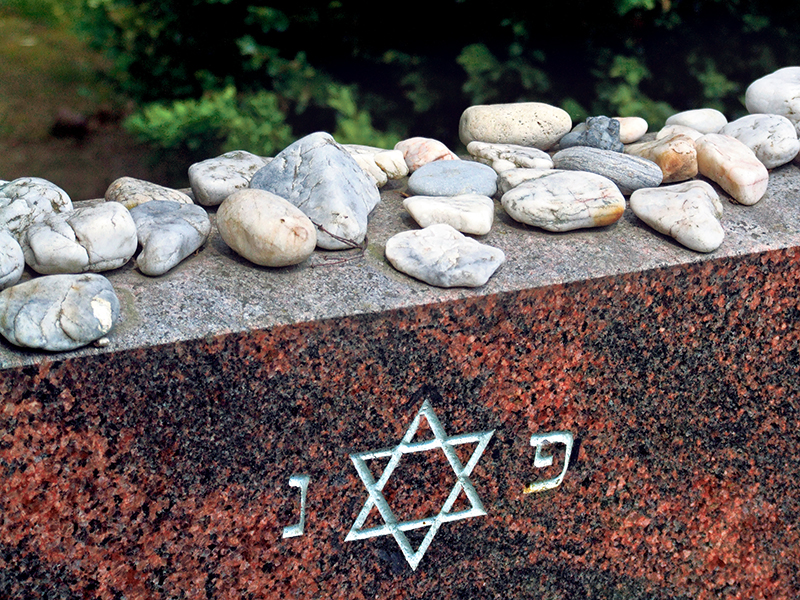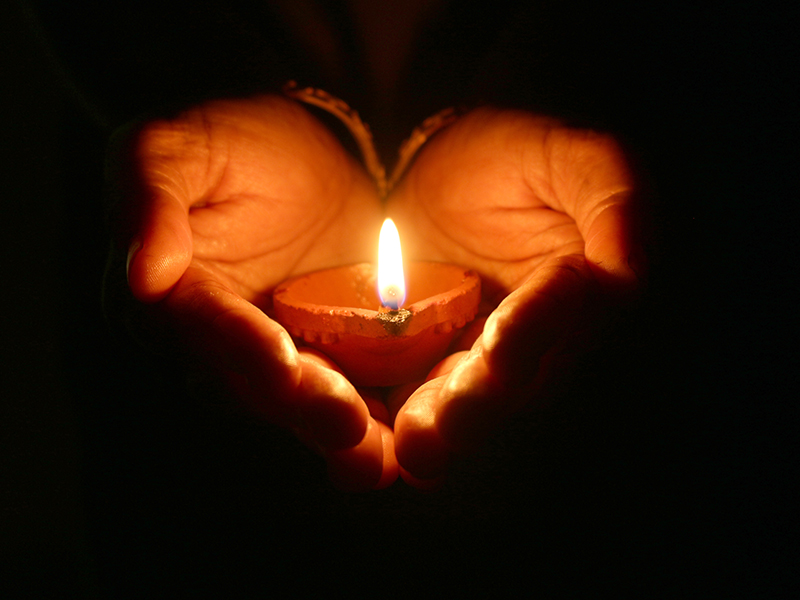Allison Best, a 32-year-old outdoor educator who lost her father almost 10 years ago, says the Jewish community “has it right” when it comes to traditions surrounding death.
Although she is not observant, Best, who sees herself as culturally Jewish, was greatly comforted by her father’s traditional funeral – held soon after his death – the shivah that followed and the unveiling of his headstone about a year later.
“There’s no ambiguity in Judaism,” Best said. “The funeral will be (held) immediately.” In contrast, she felt that healing was delayed for her non-Jewish husband’s family when they recently lost a relative, and there were no comparable rituals to fall back on before the eventual memorial service.
For Best, having family and friends surround her during the shivah, the traditional seven days of mourning following a funeral, “made things better” at a traumatic time. “There’s something beautiful in being able to hear the stories you heard as a child, and those you may not have heard before,” she said.
But the laws and customs of Jewish mourning extend far beyond funerals, shivahs and unveilings, and are observed to varying degrees across the spectrum of the Jewish community.
Rabbi Yael Splansky, senior rabbi of Holy Blossom Temple in Toronto, said that the stages of Jewish mourning – including the shivah, sheloshim (the 30 days of mourning after burial), Kaddish, unveiling and yahrzeit (the anniversary of a death) – serve as “markers in time.” With each of them, she said, “We feel a shift, and that’s what keeps us moving through our grief, not too quickly and not too slowly. Neither one of those is healthy, so we lean on the tradition.”
READ: STARRY-NIGHT SCHEHERAZADE – MEMORIES OF MY FATHER
In Humanistic Judaism, a non-theistic sect combining Jewish culture with humanist values, the funeral may not be in a Jewish funeral home and there may not be a shomer (guardian) to watch over the deceased before the burial, said Rabbi Denise Handlarski of Toronto’s Oraynu Congregation.
Humanistic Judaism offers a non-theistic alternative to Kaddish, the prayer first recited at the funeral. However, there are no gatherings or services where mourners can continue to say Kaddish on a daily basis. Instead, there are opportunities for “Nizkor,” the movement’s alternative to Yizkor, the Ashkenazic memorial prayer recited four times a year during certain yom tov services.
For information about the traditions from a modern Orthodox perspective, both Rabbi Splansky, a fourth-generation Reform rabbi, and her Conservative colleague Rabbi Philip Scheim recommended The Jewish Way in Death and Mourning by the late Rabbi Maurice Lamm.
Rabbi Daniel Korobkin of Beth Avraham Yoseph of Toronto (BAYT), called it “a go-to book” that explains the rationale behind many customs. Because much of Jewish mourning is based on custom, he recommends consulting with a rabbi to determine how it applies to individual cases.
From the moment of death, Judaism prescribes, and even facilitates, the mourning process. During aninut, the time between the moment of death and burial, those who have lost a parent, sibling, child or spouse are subject to certain laws of mourning – like not shaving, for men – but are exempt from other mitzvot, like praying, that might interfere with arranging “a respectful and expeditious burial,” Rabbi Korobkin said.
When aninut ends, tearing a piece of clothing before the funeral – an act known as keriah – is “an opportunity for psychological relief,” wrote Rabbi Lamm. (A symbolic ribbon, which he does not endorse, has become a common substitute, as well.)

Similarly, one of the purposes of sitting shivah is to provide an outlet for human emotion. “The whole function of shivah is to allow the mourner to indulge in their sadness and to console them with words that will make them feel good about the deceased,” said Rabbi Korobkin.
Cantor Daniel Benlolo of Montreal’s Shaare Zedek Congregation said that mourners at Sephardic shivahs may sit on the floor, although this is becoming less common. Also, Sephardim do not eat meat during the shivah, aside from on Shabbat.
Sephardic customs vary not just by country of origin, but also from one city to another, he noted. “That doesn’t make them right or wrong.”
Sometimes, visitors leaving a Moroccan shivah are given a small bag with mezonot, round baked goods that symbolize the circle of life, along with almonds and dried fruit, which “remind us that even though we had a hard experience, we still bless God and all his miracles,” Benlolo said.
At the end of a Sephardic shivah, there is a special meal and study session called a mishmara, at which psalms are read and the deceased is eulogized again. As well, people are encouraged to “come back to the ways of God,” said Benlolo.
At the end of sheloshim, and also at the end of the shivah, some Sephardic Jews will visit the grave of the deceased and lay a coat on the earth, “as if to say … this will keep you warm,” he said.

Both Sephardic and Ashkenazic mourners who observe the traditional bereavement process say Kaddish as part of a minyan (a traditional prayer quorum) three times a day at morning, afternoon and evening services throughout the shivah. They continue for a total of 11 months for a parent, or one month for other relatives.
Ari Gold, a Toronto endodontist who grew up modern Orthodox, said that “doing things the right way” became very important to him when his father died last year. Saying Kaddish for his father, a Holocaust survivor, was “a given.”
Gold, 57, recalled that saying Kaddish was important to his father when he lost his own mother. Although they never discussed it, Gold knew his dad would have wanted someone to say Kaddish for him.
Gold, who finished his year of mourning in February, said Kaddish at Shaarei Tefillah Congregation in Toronto. He believes it was therapeutic, but didn’t find it easy.
“I’m not a morning person,” he said. “I’m a Saturday morning shul-goer. It turned my life upside down. Wherever I was, I had to get to shul by certain times. It was very, very challenging.”
On trips, he sought out morning and evening services. At a conference in New Orleans, Gold travelled to opposite ends of the city before and after his meetings on a daily basis. “It was just important to me,” he said.
Finishing the 11 months of Kaddish took “a big load off my shoulders,” said Gold, who found reasons to persist, both for his father and himself. “Every Kaddish you say is supposed to be a blessing to elevate their soul.” At the same time, “saying it for myself allowed me to think of my father every day. It kind of connected me to him more and more.”
Rabbi Splansky noted the value of setting time aside for Kaddish: “Grieving is hard work and if you don’t give it the time and attention it requires, it gets harder later.”
Albert Kirshen, a BAYT member and palliative care physician who lost his father in 2006, said that Kaddish provides a structure that is “psychologically sound. Every single day, you’re seeing people who are mourning, so there’s a built-in community of support.”

Recently, Kirshen began saying Kaddish for his father-in-law. The practice of taking on this responsibility for a wife’s relatives is not uncommon in the Orthodox world, as only men are traditionally obligated to say Kaddish. But even in Orthodox circles, it has become more common for women to say it, too.
“Women are always welcome to say Kaddish” at his synagogue, said Rabbi Korobkin. But if no one else is saying it, “we ask a man to say it, as well, together with her,” as it’s considered “immodest for a woman to be prominent on the other side of the mechitzah” that segregates men and women, he explained.
In the Sephardic community, it is less common, but not unheard of, for women to say Kaddish. “Sephardi Jews, in general, are very traditional,” Benlolo said.
Mourners who cannot commit to regularly saying Kaddish may appoint a minyan attendee to say it for them when they are unable to make it to shul, said Rabbi Korobkin.
Rabbi Scheim believes that it is more significant for family members to say Kaddish, even if they say it less often. He noted that alternative ways of honouring a deceased loved one include text study and tzedakah.
For mourners looking for less traditional alternatives, another option is a virtual minyan done over the telephone or Internet (a quick web search will reveal a number of options).
Donna Ross, an office manager who finished 11 months of Kaddish for her mother in February, has become a minyan regular at Beth Emeth Bais Yehuda, a traditional Conservative synagogue in Toronto.
Ross said that she and her three siblings each did what was meaningful and gave comfort to them. “I really think it’s a personal thing. I got a real connection to the Beth Emeth Jewish community, and people I met there, that I never expected to get. There’s almost an unwritten language that you have,” she said.
Although she lost her father 35 years ago, saying Kaddish on a daily basis was a new experience for Ross. When her father died, Ross said Kaddish only on Saturdays, partly because she felt at the time that it was “more of a male thing to do.”
Every Kaddish you say is supposed to be a blessing to elevate their soul.
– Ari Gold
Like Gold, Ross had to make compromises in her life to get to shul and observe some of the customs of the year of mourning. Because services sometimes cut into her work hours, Ross, who works on contract, earned less during her year of mourning than she otherwise might have. “But I never looked at it from a dollars and cents perspective,” she said.
Also, because music is prohibited for those who are mourning, Ross modified her habits after she lost her mother. During the sheloshim, she didn’t watch television or listen to the radio, other than the news. After that, she didn’t “seek out” entertainment, but continued attending the theatre using subscription tickets that she had already bought.
Gold, similarly, did not attend concerts or parties with music. At weddings and bar mitzvahs, he would excuse himself from the room when the music started.
Such traditions help protect people from situations that are “not fitting for them as a mourner,” Rabbi Splansky said. She recommends that mourners suggest a quieter alternative in response to invitations they don’t feel comfortable with.
The year of mourning often ends with the unveiling of the deceased’s headstone, which makes it apparent that “now is the time to shift,” Rabbi Splansky said. “We talk about moving from the mitzvah of mourning to the mitzvah of remembering. For some families, it’s hard to let go of the mourning, so that ceremony becomes really important.”
Other end-of-year customs include offering light refreshments after morning services to commemorate the yahrzeit. In the Sephardic community, many people hold a commemorative meal called a nachalah, which includes prayers, the reading of traditional texts and symbolic foods.
Earlier this year, Gold’s son’s bar mitzvah took place the day before his father’s first yahrzeit. It didn’t go unnoticed, Gold said. “It was like the circle of life.”
